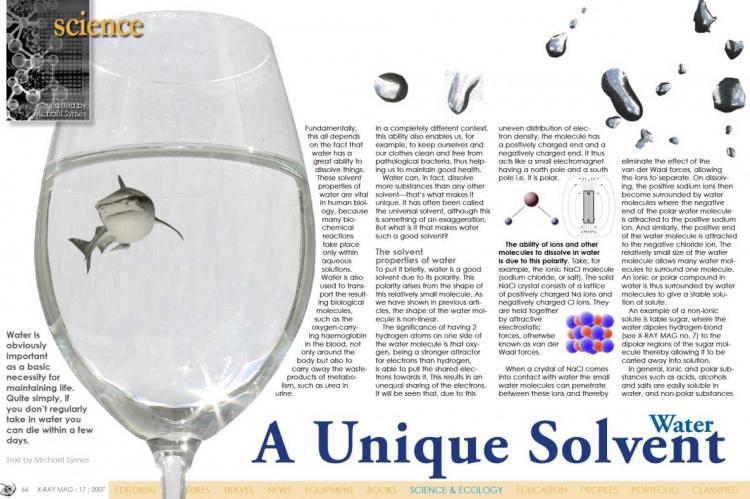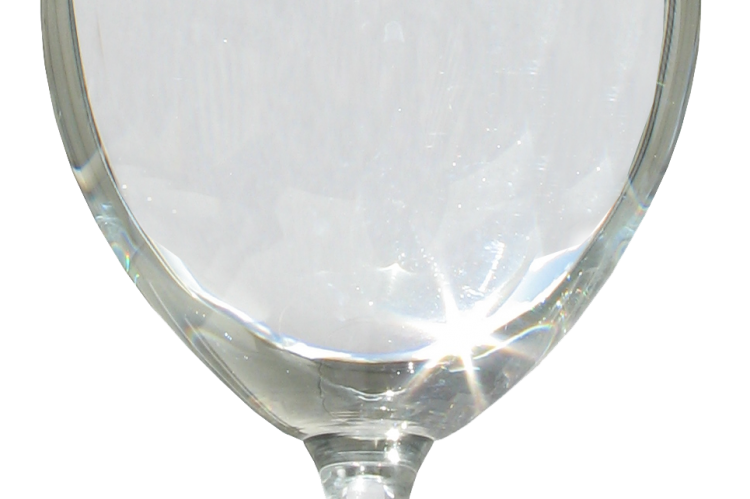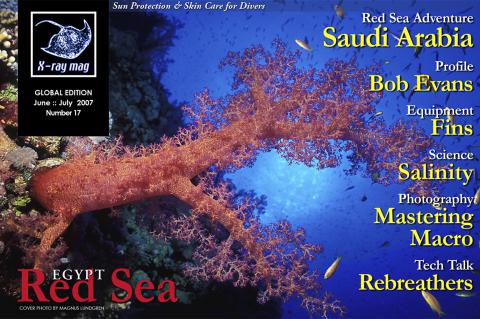Water - A Unique Solvent
Water is obviously important as a basic necessity for maintaining life. Quite simply, if you don’t regularly take in water you can die within a few days.
Tags & Taxonomy
In a completely different context, this ability also enables us, for example, to keep ourselves and our clothes clean and free from pathological bacteria, thus helping us to maintain good health.
Water can, in fact, dissolve more substances than any other solvent—that’s what makes it unique. It has often been called the universal solvent, although this is something of an exaggeration. But what is it that makes water such a good solvent?
The solvent properties of water
To put it briefly, water is a good solvent due to its polarity. This polarity arises from the shape of this relatively small molecule. As we have shown in previous articles, the shape of the water molecule is non-linear.
The significance of having 2 hydrogen atoms on one side of the water molecule is that oxygen, being a stronger attractor for electrons than hydrogen, is able to pull the shared electrons towards it. This results in an unequal sharing of the electrons. It will be seen that, due to this uneven distribution of electron density, the molecule has a positively charged end and a negatively charged end. It thus acts like a small electromagnet having a north pole and a south pole i.e. it is polar.
The ability of ions and other molecules to dissolve in water is due to this polarity. Take, for example, the ionic NaCl molecule (sodium chloride, or salt). The solid NaCl crystal consists of a lattice of positively charged Na ions and negatively charged Cl ions. They are held together by attractive electrostatic forces, otherwise known as van der Waal forces.
When a crystal of NaCl comes into contact with water the small water molecules can penetrate between these ions and thereby eliminate the effect of the van der Waal forces, allowing the ions to separate. On dissolving, the positive sodium ions then become surrounded by water molecules where the negative end of the polar water molecule is attracted to the positive sodium ion. And similarly, the positive end of the water molecule is attracted to the negative chloride ion. The relatively small size of the water molecule allows many water molecules to surround one molecule. An ionic or polar compound in water is thus surrounded by water molecules to give a stable solution of solute.
An example of a non-ionic solute is table sugar, where the water dipoles hydrogen-bond (see X-RAY MAG no. 7) to the dipolar regions of the sugar molecule thereby allowing it to be carried away into solution.
In general, ionic and polar substances such as acids, alcohols and salts are easily soluble in water, and non-polar substances such as fats and oils are not. Non-polar molecules stay together in water because it is energetically more favourable for the water molecules to hydrogen bond to each other than to engage in van der Waal interactions with non-polar molecules.
Salinity of the Oceans
For a diver, one of the most obvious facts about the water of the oceans is its salinity, due of course to the ability of water to easily dissolve all ionic salts. The salinity, as all divers know, has a great effect on buoyancy.
Salinity is a measure of the amount of dissolved salts in seawater, and is calculated as the amount of salts in grams dissolved in 1 kg of seawater. In the case of common salt, NaCl, for example, the maximum solubility is 357 grams in 1000 grams of water at 0 ºC.
About 70 percent of the Earth is covered with water, with about 97 percent of that water in the oceans. The oceans contain about 3.5 percent of dissolved minerals, so it is nowhere near a saturated solution. However, the Dead Sea has a salinity of about 30 percent, which is getting close to saturation.
The following elements make up 99.99 percent of the total mass of Earth’s ...
(...)
Download the full article ⬇︎

Originally published
X-Ray Mag #17
Red Sea - behind the scene Egypt and Saudi Arabia. FINS + interview of Bob Evans. How coral reefs change. Kurt Amslers photoschool: Macro. Safety margins on a rebreather. The Science of Salinity. Sun protection for divers. Mermaid Matters: Mascara: Medical issues: Nasal Irrigation






























